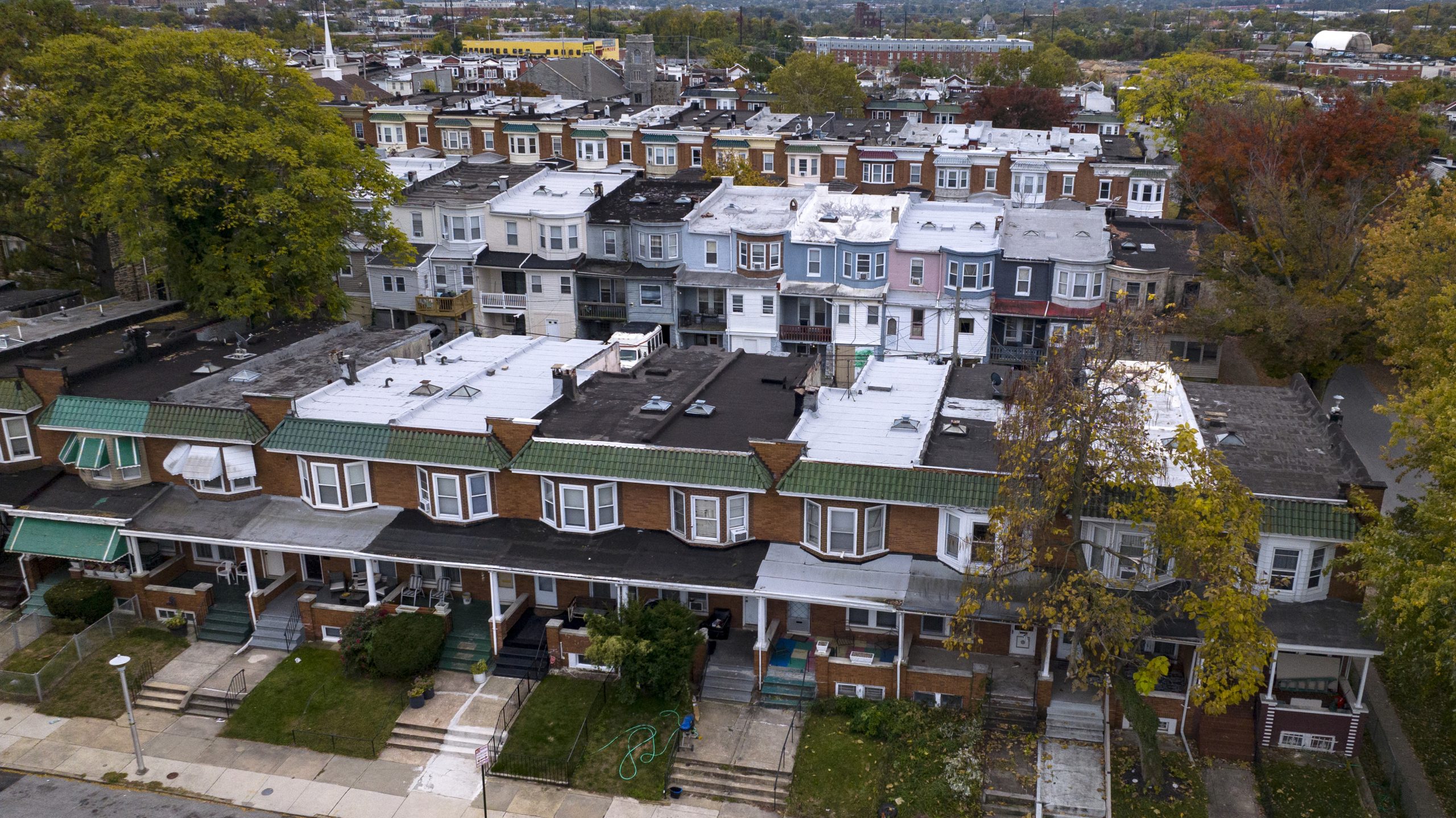[ad_1]
Tax breaks such as TIFs, PILOTS, Brownfields Credits, Enterprise Zone Tax credits are used by corporate developers across the country to defer millions worth of property taxes for decades while working class property owners pay the full tax rate. TRNN reporters Taya Graham, Stephen Janis, and longtime Baltimore reporter Jayne Miller take a deep dive into this wealth creation mechanism that remains out of the hands of the people and leaves city taxpayers on the hook.
Transcript
Taya Graham: Hello, my name is Taya Graham, and welcome to The Inequality Watch. Now, before we go any further, I know you’re used to seeing me on the Police Accountability Report, but as we always make clear on that show, bad economic policy drives bad policing, and that’s why Stephen and I produce a show called The Inequality Watch. It’s like the Police Accountability Report in that it’s all about holding power accountable, but in this case, we focus on the uber rich, not cops. And what could be wrong with that?
Anyway, on today’s show, we’re going to be talking about a long-term investigative project we’ve been working on that gets to the heart of why the rich keep getting richer and the rest of us, well, you know the rest of that story. It’s actually a project that touches on greed, government, a political economy that boils down to something you’ve probably never thought of as an instrument of wealth: an acronym. That’s right. A couple of letters put together actually spells big profits for developers.
Now, I know right now you’re saying, how can a few letters from the alphabet strung together mean big wealth through tax breaks? Well, that’s the mystery we’re going to unpack today. And to do so, I’m joined by two of the best investigative reporters in the business who have been doing a deep dive into this little inequality machine.
But first, I need all the PAR viewers to make a slight adjustment for me, at least for the moment; Stephen is going to be inside. Not for long, of course, but just for now. And of course, legendary reporter Jayne Miller can sit wherever she wants. Okay, now we’ve gotten that out of the way.
Now, like I was saying, broad economic inequality is not only widespread, but in some respects hidden. What I mean is that the processes that can heighten inequality can sometimes be cloaked inside what otherwise seems like the routine, everyday, onward march of capitalism. Case in point is what we uncovered in Baltimore and beyond regarding a tax break system that is emblematic of how our country’s inequality machine works. It’s a system for enriching developers we started uncovering as we began digging into how several apparently upscale projects are financed.
What we’ve learned is that innocuous little acronyms like TIFs or PILOTs were basically being used to exempt rich developers from paying property taxes in big cities like Baltimore and small towns alike. And the deeper we went, the more alarming this process became, because we learned that beyond all the money flowing to the elite from poor cities like Baltimore, there’s literally no transparency about how much, exactly, these breaks were worth and what they were bringing back to the city.
That’s why, five years ago, Stephen and I started to work on an investigative documentary about what we learned. It’s called Tax Broke, and it tells a story of how decades of bad public policy have created a frankly absurd situation where the wealthy developers pay little or no property tax while the working class shoulders the burden. Recently, to help us dig deeper into the numbers, we were joined by investigative reporter Jayne Miller, which led to us uncovering even more inconsistencies and red flags with this system.
But before we get to our discussion, I want to set the scene, so to speak, by showing you a clip from the documentary. And we focus on a high profile redevelopment of Port Covington, a piece of land situated near downtown Baltimore that Under Armour CEO Kevin Plank wanted to turn into a shining city by the Patapsco River. Let’s watch.
[VIDEO CLIP BEGINS]
Taya Graham: After the death of Freddie Gray in police custody, the world watched as my city, Baltimore, burned. Some called it an uprising.
Speaker 1: And there’s such a fear, a real trembling in the boots of elites at the top when poor people straighten their backs up.
Taya Graham: Others, a reckoning.
Speaker 2: We have become the most punitive nation in the world. We have constructed a penal system unprecedented in world history.
Taya Graham: But the anger on the streets was not just about policing. It was also a cry of desperation from residents who had lived with staggering poverty for decades.
Speaker 3: Because he lives in a community that historically has been abandoned. He grew up in housing that has lead paint, and then the whole uprising afterward and the community saying, no more, we’re not taking this nonsense anymore.
Taya Graham: Which made what happened next profound.
Speaker 4: So my office began working with Sagamore Development months ago to make sure that all of the people of Baltimore benefited from Port Covington.
Taya Graham: Less than a year after the unrest, the city rushed a deal through the council to approve a $660 million tax incentive, known as a TIF, to Kevin Plank, the billionaire founder of Under Armour, to build a luxury city on the water.
Speaker 5: Because the TIF was so huge, it’s the fourth biggest TIF, I think the third biggest private sector TIF in US history, the biggest TIF this side of the Mississippi, we couldn’t ignore it.
Taya Graham: My reporting partner, Stephen Janis, and I followed the story. But despite all the promises and protests, the deal was approved.
Speaker 6: For all the money that’s being poured into Baltimore City, it’s just not coming out to us. It’s not enough coming out to us.
Taya Graham: And that wasn’t the only tax break fueling construction downtown. Another type of incentive, known as a PILOT, was approved for all new apartment buildings with more than 20 units just before the uprising. A move prompting a massive build out of luxury apartments, all amid a public housing crisis, when advocates struggled to get the city to set aside a small sum to build affordable housing.
Speaker 7: We need for our city leaders to be more than leaders at the podium, we need for them to join us in this great cause.
Taya Graham: And so in a city where a young Black child has less of a chance of making it out of poverty than a child in many Third World countries, people who were already rich seemingly got richer.
[VIDEO CLIP ENDS]
Taya Graham: But that is just the beginning of the story. And to break down what we’ve learned since we started this and how we’ll move forward with our investigation, I’m joined by Stephen Janis and Jayne Miller. Thank you both for joining us.
Stephen Janis: Thanks for having us.
Taya Graham: So, because there’s a debate about whether a TIF is a tax break or a tax subsidy and who benefits, just tell me, what is a TIF?
Stephen Janis: Well, a TIF is something known as Tax Increment Financing. But the basic idea and how it was created was simply to take abandoned properties in big cities that no one wanted to build on and find a way to incentivize development. And what came out of that was this idea that any new value created would be exempt from taxes, and the tax that would normally be paid would be used to invest in the property. But it’s the mechanism of how this works that makes it really, really beneficial and difficult to judge as being used as originally designed.
And primarily, what I mean by that, is they don’t say, for example, estimate what it would cost to build infrastructure or something on a site. What they do is just estimate some conflated future value of the project, and then give the property developer all the future taxes, sometimes 30 or 40 years, upfront. They use Wall Street to finance this, so Wall Street makes tons of money with what we’ve learned are much more expensive bonds than they would normally use.
And thus creating this great wealth inflater for developers. And especially in Baltimore, because you look at Harbor Point, for example, the developer made a lot of money selling this property, but all of it was financed by the public taxpayers. It’s all financed by public dollars. And that’s basically what happens. Because if you get that much property tax in advance, you’re pretty much getting all the money you need to do to finance the deal. So it is public financing of private profit, basically.
Taya Graham: So Jayne, development is actually important for a city.
Jayne Miller: Absolutely.
Taya Graham: Why did you decide to dig in and investigate this?
Jayne Miller: Well, look, everybody wants good development that benefits everybody or has great benefit for the city. So the question that we have raised in the work we’ve done is in Baltimore, is it fair, is it equitable, and is there benefit beyond the particular project itself? And so what we’ve found is that the subsidy that is going on in the city of Baltimore, what we’re really doing is subsidizing already valuable property, first of all, and affluent development. So we have tax credits that are available to apartment builders who are building these high-end apartment buildings, without any component or any real intention here on affordable housing. So I think, yes, development is good – If it is fair, if it is equitable, and it serves a greater good.
Taya Graham: Well, Stephen, this doesn’t just happen in a city like Baltimore. It happens in small towns too. It happens even in larger cities. So can you talk a little bit about some of our investigative reporting and what it revealed in Milton, West Virginia, which has roughly 2,500 people?
Stephen Janis: You would think that this type of tax credit would only be something that a big city could take advantage of, because what would be the point? But what we found doing reporting across the country, was that very small, poor communities are offering these kinds of lucrative tax breaks to spur development, and one would say, questionable development. In this case, in Milton, West Virginia, there was a failed coal baron named Jeff Hoops, who had bankrupt Blackjewel Coal, which had left coal miners, who had actually already received paychecks, had them clawed back from their accounts. So he caused a huge big mess. But at the same time, a small town in Cabo County, West Virginia, named Milton, was giving him a $15 million tax break to build… I don’t think they titled it ironically, but the Grand Patrician Hotel. I mean, given what we’re talking about.
And like Baltimore, a poor city, a city struggling with concentrated poverty, people making $22,000 annually, per annum, per house, much lower than the national average in Cabell County, about 40,000, about half the national average. Very poor county, very poor people. And yet, they used this lucrative tax break for a guy who had just bankrupted his company.
Now, this was in 2018, but we came upon this in 2021, and the hotel was just still sitting there like a shell. And we also uncovered that after we started reporting, they gave him the tax rate after the original bank that was supposed to handle the deal had resigned without comment. So these things just perpetuate themselves.
We found that the firm that was supposed to be reporting back to the taxpayers was also paid by Jeff Hoops, a law firm. But the reason I bring this up, it sounds sort of like inside baseball, but the point is, these are all interconnected. There’s no outside authority, as Jayne was saying, there’s no objective, transparent analysis of what we’re getting for our money. And that, I think, is intentional.
Taya Graham: So Jayne, I know this is also happening in bigger cities like Chicago. Can you talk a little bit about what’s happening with TIFs there?
Jayne Miller: Well, first, yes. First of all, let’s start with Chicago. The Tax Increment Financing was used so extensively, it covered a whole bunch of the land of Chicago. So recently, within the past couple of years, the mayor of Chicago actually set up an oversight commission to keep an eye on and to oversee and supervise the use of Tax Increment Financing. This is something that, in Baltimore, would be extraordinarily useful, is to have real oversight of the use of this kind of financing.
As we sit here, according to the most recent annual financial report for the city of Baltimore, the city has already committed to almost $600 million in diversion of property taxes over coming years to pay off the TIF bonds. And that’s a growing number, because more bonds get sold as these projects go forward. So it would be very useful and serve the goal of transparency if there was greater oversight of the use of these kinds of subsidies, tax breaks, tax credits, et cetera so that, A, you how much you’re diverting from the general fund, and you start to ask the question, what are we getting for it?
Taya Graham: Right.
Stephen Janis: And just to add to what Jayne said, there’s not a day that goes by that Jayne doesn’t call me and say, I found another one [Jayne and Taya laugh]. And when I say that, I mean another weird tax break that wasn’t really used as intended, that was saving developers more money, but also making all this impossible to figure out the big picture, as you say in the documentary, what are we really paying? We don’t know.
Taya Graham: Well, why don’t you drill down a little bit into what’s actually happening here in our city, Baltimore, with TIFs?
Stephen Janis: Well, with TIFs, we started out small with small TIF projects, Jayne, right, like Belvedere Square –
Jayne Miller: 20 years ago or so. Right.
Stephen Janis: But then suddenly, someone got the idea that the whole way to transform Baltimore was to be offered larger and larger TIFs, namely Harbor Point, which is about $108 million – On face value deal, not including interest. And then Port Covington, which was a $600 million, I think at that time, the fourth largest in the history of the country. So it’s really grown into it.
And what Jayne and I have uncovered is around that grows an industry meant to make it, keep it going. Like the firm MuniCap, which is supposed to analyze these deals for the taxpayers and say whether they are necessary. But turns out, we found that MuniCap also gets paid when the bonds are issued for the TIFs. So they say, hey, this is great, and then they collect on this great thing that they say was great.
Jayne Miller: Working both sides of the deal.
Stephen Janis: Right, working both sides of the deal. So Baltimore has developed this culture of TIFs, this culture of developers. And Jayne, maybe you can talk about this, where developers feel entitled to these tax breaks.
Jayne Miller: Well, I think this is really an important point of the culture that is created when a city increasingly uses and awards tax breaks. This really started in earnest in Baltimore in the mid to late ’90s with this extraordinary tax break for the construction of a hotel in a waterfront community, Harbor East, where the developer, who happens to be the baker John Paterakis, who’s also a developer, was awarded a tax break that had him paying a dollar per year, $1 per year in property tax for 25 years. This is still in effect. And so tens of millions of dollars have not been paid, have been abated on this particular project.
And from there, in the late ’90s, early 2000s, we really started this practice, this culture of awarding tax subsidy and tax breaks to developers mostly on the waterfront, which is Baltimore City’s most valuable land, no question, is on the waterfront. And the argument that many can make is that we don’t need to subsidize land that’s already valuable and is already appealing. Other developers would do this without all these tax breaks. And that’s the question that has been avoided for years in Baltimore as the number of these credits and new credits have been brought on board, have been implemented, which is, do we really need to do what we’re doing?
Taya Graham: Well, you know what, I wanted to ask you, Stephen mentioned Port Covington, which was supposed to be developed by Under Armour CEO, founder, Kevin Plank.
Jayne Miller: Yeah, very well known company, correct.
Taya Graham: So can you talk a little bit about what we saw with that particular TIF and what the status of the project is now?
Jayne Miller: Well, this was a big debate in 2016 about awarding this $660 million Tax Increment Financing deal to build out this piece of waterfront property in the very Southern tip of Baltimore City. And it started out with this grand concept of what it was going to be, with big Under Armour headquarters, et cetera. So as the years went on since 2016, they didn’t sell the first bonds under the TIF deal until 2020. So the construction has started, and some buildings are under construction, but at the moment it does not look anywhere near what it looked like in the original concept. And I think at this point, I think there are four or five buildings that are nearly built. I think at this point it’s a reasonable question to ask, is what’s ahead for this project in comparison to the way it was sold? It’s already been renamed from Port Covington to Baltimore Peninsula. It is an isolated part of the city.
Stephen Janis: Not integrated [crosstalk].
Jayne Miller: Right. City planners are going to argue, look, you kind of want your development to integrate and to have a spillover effect to surrounding communities so it has a greater benefit. In this case, this is an entirely isolated parcel of land, actually hard to get to because of Interstate 95, and it is not exactly connected to other communities and to other parts of the city. So it’s going to be very interesting in the next couple of years to see what that really ends up being.
Taya Graham: Well, Stephen, these aren’t the only tax breaks that you’ve been looking at, right?
Stephen Janis: Oh, not at all. We have so many in process right now. We have the former Perkins Homes, which was a low income housing complex right near Fells Point, and very approximate to Harbor East. That is now part of a massive TIF which is just unfolding, which has required them to build more luxury apartments than before. And then we have Harbor Point, which is still always ongoing. We also have what is called a PILOT, a Payment in Lieu of Taxes, that is available to all new apartment buildings. So almost any new apartment building over 20 units that you see in Baltimore is getting a 10-year tax break.
Taya Graham: Wow.
Stephen Janis: Yeah, so we’ve been looking into other buildings. And I don’t know, Jayne, if you want to talk about the brownfields a little bit?
Jayne Miller: Well, we’re looking further, there is a credit that is offered by the state and then the city reimburses for it for brownfields. This just has to do with environmental damage. And a city like Baltimore, within all its industrial uses, et cetera, et cetera, you could argue the whole city is like a brownfield. But there have been some questions raised to us, and kind of encouraged us to really look at this, so that we’re looking at the use of that particular credit.
We also have enterprise zone credits. Again, a city like Baltimore would have a lot of enterprise zone credit territory.
Stephen Janis: Which is credit that was created about 30 years ago that’s supposed to assist, give companies benefits to create jobs in poor neighborhoods. But right now, like the brownfields, the entire city is almost technically an [inaudible].
Taya Graham: So wait a second. How far does this rabbit hole go [all laugh]? I mean, what’s happening here?
Jayne Miller: You know it’s a rabbit hole because there’s no transparency of the rabbit. Now we have a situation where these credits are just kind of awarded. Back in the day, when they started, there would be city council hearings. In fact, the first one, which I talked about, was the hotel, the Payment in Lieu of Tax agreement with the hotel, that was a big deal. Controversial, we had hearings. That’s all gone away, and now it’s just kind of a standard operating procedure. This is the way we do business.
Stephen Janis: Yeah, it’s more like an entitlement system.
Jayne Miller: Right. It’s exactly right.
Stephen Janis: It’s entitlement.
Jayne Miller: You build a certain kind of building, you get this credit. You build somewhere in this particular place and you could try to claim this kind of credit. There’s no process, there’s very little oversight, and it’s very difficult to find on a year to year basis, okay, so how much money’s involved?
And most of all the, they’re supposed to, the goal here is, okay, we’re going to do this development, it’s going to create jobs. Well, okay, temporary construction jobs, sure. But then beyond that, what’s the impact? Has it increased the employment base, the tax base, and the population base of Baltimore City? And that’s a big question, as since 2010, we’ve lost 35,000 people, and we continue to lose population.
Taya Graham: You know what, in fact, I want to show you what kind of rabbit hole we are going down. Let’s run a video clip of a city council meeting we attended where a very modest study of these tax breaks were proposed, and we were rather surprised by the results.
[VIDEO CLIP BEGINS]
Speaker 8: This legislation requires that the Department of Finance produce a report about the impact of our Tax Increment Financing projects and policies so far. Examination of some of the reasons why some have failed. I had one in my district that failed.
Speaker 9: I question studies because I, through projects within my district, when we get studies, it seems to continue to delay and delay the project.
Speaker 10: So I see the TIFs already working. We should not be doing this, but right now the TIF works.
Speaker 11: Okay. Is there a motion to move the bill favorably as amended? Seconded by Dorsey, Costello’s a no, Burnett?
Speaker 12: Yes.
Speaker 11: Dorsey?
Speaker 13: Yes.
Speaker 11: McCray? This bill fails with four votes in opposition, three in support. Okay, next bill…
Jayne Miller: Did you just see that?
Stephen Janis: Yeah. Yeah.
Jayne Miller: Did you just see that shit?
Stephen Janis: How often does it happen when a council votes against a colleague who just has something, wants a report on something?
Jayne Miller: I don’t know. I’ve only been here for two years. I’m sure it’s happened before.
Stephen Janis: You seemed upset though.
Jayne Miller: Oh, I’m pissed. I’m really upset. I mean, I had no inclination that there was going to be any problem.
[VIDEO CLIP ENDS]
Taya Graham: So Jayne, you’ve been covering City Hall for a few decades.
Jayne Miller: Long time.
Taya Graham: Were you surprised by what you saw there?
Jayne Miller: That day? I was kind of texting with someone else, one of the business reporters in town, about going, and I hear this kind of out of one ear, I hear these no votes. I’m like, wait a minute. They just defeated this. This is a simple thing. This was a study, $30,000 study. The administration in the mayor’s office had already approved they were going to do it. Just to look at the effectiveness, to get some information about whether Tax Increment Financing was beneficial to the greater good. That’s really what it was. I don’t think it was going to be any big deal. They voted it down, never got out of committee. Not the first time that this has happened.
Back 10 years ago, there was a bill to set up an oversight panel for tax breaks, et cetera, and never got out of committee. There has been this baffling reluctance in the city to really have a mechanism of transparency and oversight of these kinds of subsidies.
Taya Graham: Stephen and Jayne, I have to ask, where is this investigation going to take you next?
Stephen Janis: Well, we’re about 50 feet down the rabbit hole right now [Taya and Jayne laugh], so I think another 100 feet. But what I think, while we were saying there is no transparency and there is no number, in the documentary we do some numbers, and we’re just going to keep pushing to complete this picture. Like a puzzle, we’re just going to keep getting the pieces. Where I think it’s leading is we’re going to learn that, pretty much, if we have a tax break variety store for developers. You go and say, hmm, do I want a brownfields credit or do I want an enterprise zone credit? What do you think?
Jayne Miller: Or something that you got both of them.
Stephen Janis: What looks good? Oh yeah, [crosstalk].
Jayne Miller: They’re different things. Right. Exactly.
Stephen Janis: And our main goal here is to disrupt that little store they have going on where they give a politician $500 to go and pick out a tax break. It makes no sense. It’s not good economic policy even if you want.
And also looking deeply into other alternatives to how this can be done, how we can tax a city fairly so that the residents of this city and other small towns aren’t paying higher taxes than the wealthiest people in the nation. So we’re really going to keep looking down the hole.
Taya Graham: All right. Well, I want to thank you both so much for joining me. Thank you, Stephen Janis.
Stephen Janis: Thanks for having me.
Taya Graham: And thank you, Jayne Miller.
Jayne Miller: Thank you, Taya.
Taya Graham: We appreciate you so much.
Jayne Miller: A lot of work to do. That’s right.
Taya Graham: Absolutely.
Now this is just the beginning of the story. There is so much more reporting to do and, frankly, facts to uncover that the public officials just don’t want you to know. And along with frequent updates on our reporting, we’ll be posting the full documentary of Tax Broke with a live chat right here in a few months on the Real News YouTube channel.
But what I want to make clear today is that what we’re actually doing here is deconstructing the narrative that being rich is being better. In other words, accumulating cash is a reflection of a certain type of superiority that justifies the bad policy which makes it possible. Which is why we’re going to use our reporting and the documentary and these shows to hit back at that same narrative. We are going to change the story, or, perhaps put better, offer a more fair and accurate way the story is told. And we will achieve this by holding the hoarders of extraordinary wealth and the power that comes with it accountable.
I’d like to thank my guests, Stephen Janis and Jayne Miller, for their incredible investigative reporting. My name is Taya Graham, and I’m your host of The Inequality Watch. Thanks for joining me.
Maximillian Alvarez: Thank you so much for watching The Real News Network, where we lift up the voices, stories, and struggles that you care about most. And we need your help to keep doing this work. So please, tap your screen now, subscribe, and donate to The Real News Network. Solidarity forever.
Related
[ad_2]














